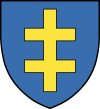Jagiellon dynasty
| Jagiellonian dynasty | |
|---|---|
 |
|
| Country |
|
| Parent house | Gediminids |
| Titles |
King of Poland King of Hungary King of Bohemia King of Croatia King of Dalmatia King of Rama King of Serbia King of Bulgaria King of Slavonia Grand Duke of Lithuania Duke of Silesia Duke of Ruthenia Duke of Luxembourg |
| Founded | 1386 |
| Founder | Władysław II Jagiełło |
| Final ruler | Anna Jagiellon of Poland |
| Dissolution | 1572 |
The Jagiellonian dynasty was a royal dynasty, founded by Jogaila, the Grand Duke of Lithuania, who in 1386 was baptized as Władysław, married Queen regnant (also styled "King")Jadwiga of Poland, and was crowned King of Poland as Władysław II Jagiełło. The dynasty reigned in several Central European countries between the 14th and 16th centuries. Members of the dynasty were Kings of Poland (1386–1572), Grand Dukes of Lithuania (1377–1392 and 1440–1572), Kings of Hungary (1440–1444 and 1490–1526), and Kings of Bohemia (1471–1526).
The personal union between the Kingdom of Poland and the Grand Duchy of Lithuania (converted in 1569 with the Treaty of Lublin into the Polish–Lithuanian Commonwealth) is the reason for the common appellation "Poland–Lithuania" in discussions about the area from the Late Middle Ages onward. One Jagiellonian briefly ruled both Poland and Hungary (1440–44), and two others ruled both Bohemia and Hungary (1490–1526) and then continued in the distaff line as a branch of the House of Habsburg.
The Polish "Golden Age", the period of the reigns of Sigismund I and Sigismund II, the last two Jagiellonian kings, or more generally the 16th century, is most often identified with the rise of the culture of Polish Renaissance. The cultural flowering had its material base in the prosperity of the elites, both the landed nobility and urban patriciate at such centers as Cracow and Danzig.
...
Wikipedia
